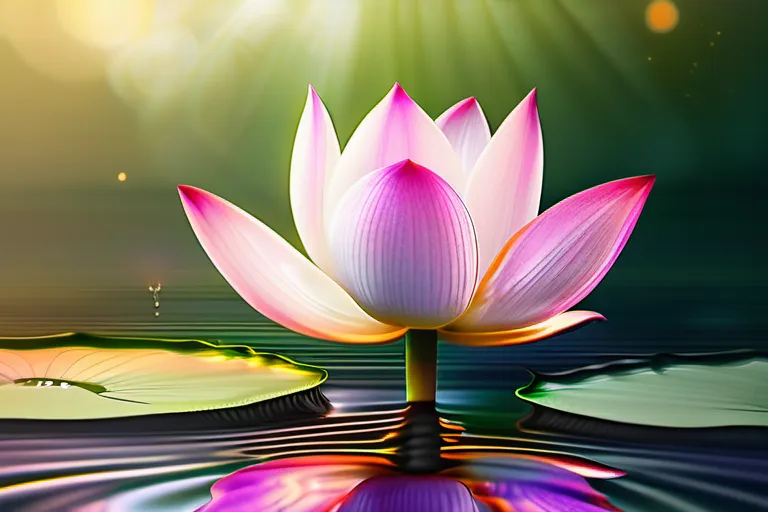Explore the fundamental principles, types, and implications of karma in this SEO-friendly article.
Karma, an essential concept in many Eastern philosophies and religions, is a belief that one’s actions have consequences that affect one’s future. In this detailed guide, we will delve into the profound aspects of karma, its various types, and how it impacts our lives.
Origins of Karma: Ancient Beliefs and Modern Interpretations
Imagine a world where every action you take, no matter how small, has an invisible thread that ties it back to your life in some way. This concept is at the heart of karma, a belief system that has fascinated and perplexed humans for centuries. The origins of karma can be traced back to ancient texts like the Bhagavad Gita and the Upanishads, where it was first mentioned as a principle of cause and effect.
But how did this idea evolve from its initial mention in ancient India into something that now resonates across cultures? Was karma always understood in the same way? Let’s explore the journey of karma through time. In early Hinduism, karma was closely linked to dharma, or one’s duty and righteousness, suggesting that actions could determine one’s social status and ultimate salvation.
In Buddhist traditions, karma took on a more complex role. Here, it wasn’t just about personal salvation but also about the cycle of rebirth and the consequences of one’s thoughts and actions. How did these teachings spread beyond India? With the expansion of trade and religion, ideas like karma reached far corners of Asia, influencing Chinese, Japanese, and Tibetan cultures, each interpreting it in its own unique way.
The modern interpretation of karma is perhaps the most fascinating aspect. In today’s world, where technology and global communication connect us all, the idea that our actions have consequences has gained new relevance. Some see it as a moral guide to living, while others view it as a metaphor for personal growth and responsibility.
So, as we delve into the principle of karma in the next chapter, let’s consider how these ancient beliefs continue to shape our modern understanding of right and wrong, good and bad. The journey of karma is not just about the past but also about its enduring relevance in today’s complex world.
The Principle of Karma: Cause and Effect
Imagine life as a vast garden, where every seed you plant and nurture eventually blossoms into something tangible. This metaphor captures the essence of karma—a principle that holds each action has a corresponding consequence. But what exactly is this mysterious force? How does it shape our lives?
Karma isn’t just a concept found in ancient texts; it’s a dynamic force that permeates modern life, influencing everything from personal experiences to societal trends. It operates on the simple yet profound principle of cause and effect, often referred to as “What goes around comes around.”
In this journey through understanding karma, we’ll delve deeper into its fundamental principles. Karma doesn’t discriminate; every action, no matter how small or large, has an impact. For instance, a kind act can lead to inner peace and positive relationships, while harmful actions might result in negative consequences.
Consider the ripple effect of throwing a stone into a pond: it creates waves that spread outwards. In the same way, every action sends ripples through time, influencing not just immediate outcomes but also future circumstances. This ongoing chain reaction is what makes karma such an intriguing and complex concept.
But how can we navigate this intricate web of causes and effects? The key lies in awareness—being mindful of our actions and their potential consequences. By cultivating ethical behavior and positive intentions, we can shape a more favorable future for ourselves and others.
In the next chapter, we’ll explore the three primary types of karma: good (dharma), bad (adharma), and neutral (karma). Understanding these distinctions will help us better navigate our actions in this complex world. For now, let’s embrace the wisdom that every choice we make is not just a momentary decision but a thread woven into the fabric of our lives.
What kind of seeds are you planting today? How do your actions shape the garden of your life?
Types of Karma: Good, Bad, and Neutral Actions
Now that we’ve explored the fundamental principle of karma as cause and effect, let’s dive deeper into the types of actions according to this ancient wisdom: good (dharma), bad (adharma), and neutral (karma). Each type carries its own weight and impact on our lives. Have you ever wondered why some people seem to have a fortunate life while others face hardships? Could it be that these outcomes are shaped by the types of actions they choose?
Let’s start with good actions, or dharma. These are deeds performed in accordance with one’s duty and responsibilities, whether towards oneself, family, community, or society at large. Think about planting a tree – it not only benefits you by providing shade but also serves the environment. Similarly, good actions bring positive karma, nurturing your spiritual growth and potentially leading to better circumstances in life.
On the other hand, bad actions, or adharma, involve doing harm or neglecting one’s duties. Imagine stepping on a butterfly; while it might seem like an insignificant act, it disrupts its natural cycle. Bad actions can lead to negative karma, which may result in less favorable situations for you or those around you. These actions can be subtle or overt, from lying to engaging in destructive behaviors.
The neutral actions, or karma, are the ones that don’t significantly benefit others or harm them but still contribute to your overall life. For example, completing a routine task at work might not bring immense joy, but it fulfills a necessary role. Neutral actions can be seen as the foundation upon which good and bad actions build their impact.
It’s important to recognize that the balance of these three types of actions influences our karma. By performing more dharma, we can cultivate positive energy and attract favorable outcomes, while striving to avoid adharma to prevent negative repercussions. Understanding this interplay helps us make mindful choices in our daily lives.
How do you balance your good, bad, and neutral actions? Are there areas where you could focus more on dharma or minimize adharma?
Karma and Reincarnation: The Cycle of Life
Imagine karma as a cosmic tapestry, woven with threads from your every action and thought throughout life after life. In this chapter, we delve into the intricate relationship between karma and reincarnation, exploring how actions in one lifetime can shape your future existence.
Karma is often seen as a force that propels souls through an endless cycle of birth, death, and rebirth. But what exactly does this mean? When you take a step back, reincarnation isn’t just about being reborn; it’s about evolving and learning from each life. Each time you’re born again, the weight of your past actions—both good (dharma) and bad (adharma)—carries forward into this new existence.
Consider the metaphor of planting a seed in fertile soil; it grows and bears fruit based on its conditions. Similarly, our lives are like seeds sown by the karmic actions of our past. The quality of our current life is directly influenced by what we planted in previous lifetimes. Good deeds nurture positive outcomes, while negative actions may result in challenges or difficulties.
But this cycle isn’t just about punishment and reward; it’s a journey of self-discovery and personal growth. Each lifetime presents new opportunities to understand the consequences of our choices. By reflecting on your past lives, you can gain insights into why certain events occur in this life, helping you make more informed decisions moving forward.
The question arises: How do we break free from this endless cycle? Some traditions suggest that true liberation comes when one reaches a state of perfect balance, where all karmic debts are cleared. This isn’t just about accumulating good karma; it’s about understanding and integrating the lessons learned from every life experience.
In essence, the relationship between karma and reincarnation is a profound dance of cause and effect. It challenges us to live with intention, considering not only our actions but their lasting impact on future lives. As you navigate through this cycle, remember that each step you take shapes your destiny in ways both subtle and profound.
The Role of Karma in Modern Society
The role of karma in modern society is often seen as an abstract concept, but it carries profound implications that are increasingly relevant in today’s interconnected world. Have you ever wondered how your actions impact not just yourself but also those around you? Karma serves as a moral compass, guiding us to consider the consequences of our choices.
Imagine karma as a garden where every seed you plant determines the landscape of your life. How do we cultivate this garden in a way that benefits both ourselves and others? In modern society, understanding karma can help individuals make ethical decisions that resonate with global values such as sustainability and social justice.
Karma also plays a crucial role in fostering community harmony. When individuals act with integrity and compassion, they create a ripple effect of positivity that strengthens societal bonds. How can we leverage the principles of karma to build more cohesive communities?
In the business world, companies that embrace ethical practices driven by karma are likely to succeed. They not only contribute positively to society but also attract like-minded consumers and employees. Could understanding karma guide businesses towards sustainable growth and innovation?
Karma’s influence extends into personal relationships as well. By practicing empathy and kindness, we can enhance our interpersonal connections and foster deeper bonds with family, friends, and colleagues. How might embracing the essence of karma transform our social interactions for the better?
Moreover, in a digital age where information spreads rapidly, the ethical implications of our online actions are more pronounced than ever. What we post or share can have far-reaching effects. How do we navigate this virtual landscape with a mindful approach to karma?
The role of karma is multifaceted and timeless, yet its applications in contemporary society offer new insights and challenges. By integrating the principles of karma into our daily lives, we can create meaningful change and build a more compassionate world.
Cultivating Positive Karma: Living a Life of Harmony
Cultivating positive karma isn’t just about doing good deeds; it’s about creating a life where your actions resonate positively within and around you. Imagine karma as the invisible thread that ties every action to its consequence, much like how a vine is woven into the fabric of a tapestry. Just as each stitch adds depth and beauty to the design, our daily choices can enrich or detract from the richness of our lives.
So, how do we start on this journey? The first step is acknowledging that every action has an impact. Reflect on your decisions: Are they rooted in kindness, or are they driven by selfish desires? By examining your motivations, you can begin to align your actions with positivity and compassion. It’s like choosing the right colors for a painting; each choice contributes to the overall harmony of the piece.
Another crucial aspect is practicing mindfulness. Being present in the moment allows you to make conscious choices that benefit both yourself and others. Consider situations where you might have acted out of anger or frustration—what would a more mindful approach look like? This shift can lead to healthier interactions and deeper connections with those around you.
Lastly, embrace gratitude as a daily practice. When you focus on what you’re thankful for, it shifts your perspective and encourages positive interactions. Think about the small acts of kindness that others have shown you and how you can pay them forward. It’s like spreading seeds in a garden; each good deed nurtures a better environment for everyone.
By cultivating these habits, you not only improve your own well-being but also contribute to a more harmonious world. Remember, every positive action, no matter how small, is a step towards creating a tapestry of karma that benefits all.
Conclusion
 By understanding karma, we can gain a deeper appreciation for the interconnectedness of all beings and strive to create positive actions that foster harmony and growth.
By understanding karma, we can gain a deeper appreciation for the interconnectedness of all beings and strive to create positive actions that foster harmony and growth.











